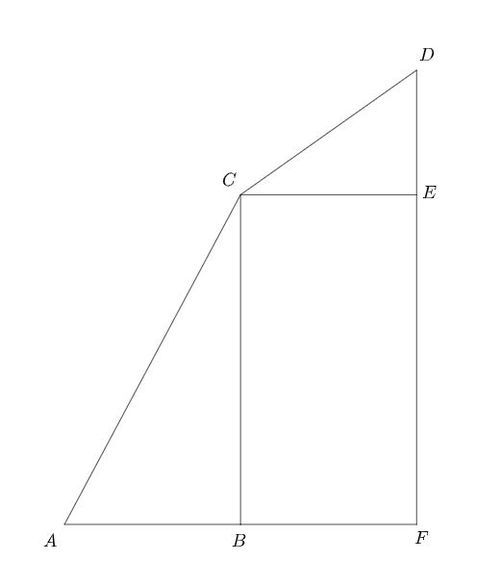2014 AMC 12A Problems/Problem 17
Problem
A ![]() rectangular box contains a sphere of radius
rectangular box contains a sphere of radius ![]() and eight smaller spheres of radius
and eight smaller spheres of radius ![]() . The smaller spheres are each tangent to three sides of the box, and the larger sphere is tangent to each of the smaller spheres. What is
. The smaller spheres are each tangent to three sides of the box, and the larger sphere is tangent to each of the smaller spheres. What is ![]() ?
?
![[asy] import graph3; import solids; real h=2+2*sqrt(7); currentprojection=orthographic((0.75,-5,h/2+1),target=(2,2,h/2)); currentlight=light(4,-4,4); draw((0,0,0)--(4,0,0)--(4,4,0)--(0,4,0)--(0,0,0)^^(4,0,0)--(4,0,h)--(4,4,h)--(0,4,h)--(0,4,0)); draw(shift((1,3,1))*unitsphere,gray(0.85)); draw(shift((3,3,1))*unitsphere,gray(0.85)); draw(shift((3,1,1))*unitsphere,gray(0.85)); draw(shift((1,1,1))*unitsphere,gray(0.85)); draw(shift((2,2,h/2))*scale(2,2,2)*unitsphere,gray(0.85)); draw(shift((1,3,h-1))*unitsphere,gray(0.85)); draw(shift((3,3,h-1))*unitsphere,gray(0.85)); draw(shift((3,1,h-1))*unitsphere,gray(0.85)); draw(shift((1,1,h-1))*unitsphere,gray(0.85)); draw((0,0,0)--(0,0,h)--(4,0,h)^^(0,0,h)--(0,4,h)); [/asy]](http://latex.artofproblemsolving.com/9/d/8/9d894dbf42883508d51bf4973c78d1368570c6fa.png)
![]()
Solution
Let ![]() be the point in the same plane as the centers of the top spheres equidistant from said centers. Let
be the point in the same plane as the centers of the top spheres equidistant from said centers. Let ![]() be the analogous point for the bottom spheres, and let
be the analogous point for the bottom spheres, and let ![]() be the midpoint of
be the midpoint of ![]() and the center of the large sphere. Let
and the center of the large sphere. Let ![]() and
and ![]() be the points at which line
be the points at which line ![]() intersects the top of the box and the bottom, respectively.
intersects the top of the box and the bottom, respectively.
Let ![]() be the center of any of the top spheres (you choose!). We have
be the center of any of the top spheres (you choose!). We have ![]() , and
, and ![]() , so
, so ![]() . Similarly,
. Similarly, ![]() .
. ![]() and
and ![]() are clearly equal to the radius of the small spheres,
are clearly equal to the radius of the small spheres, ![]() . Thus the total height is
. Thus the total height is ![]() , or
, or ![]() .
.
(Solution by AwesomeToad)
Solution 2
Let ![]() be the center of the large sphere and
be the center of the large sphere and ![]() be the center of any small sphere. Let
be the center of any small sphere. Let ![]() be a vertex of the rectangular prism closest to point
be a vertex of the rectangular prism closest to point ![]() . Let
. Let ![]() be the point on the edge of the prism such that
be the point on the edge of the prism such that ![]() and
and ![]() are perpendicular. Let points
are perpendicular. Let points ![]() and point
and point ![]() lie on
lie on ![]() and
and ![]() respectively such that
respectively such that ![]() and
and ![]() are perpendicular at
are perpendicular at ![]() .
.
![]() is the radii of the spheres, so
is the radii of the spheres, so ![]() .
. ![]() is the shortest length between the center of a small sphere and the edge of the prism, so
is the shortest length between the center of a small sphere and the edge of the prism, so ![]() . Similarly,
. Similarly, ![]() . Since
. Since ![]() is a rectangle,
is a rectangle, ![]() . Since
. Since ![]() ,
, ![]() . Then,
. Then, ![]() .
. ![]() is the length from
is the length from ![]() to the top of the prism or
to the top of the prism or ![]() . Thus,
. Thus, ![]() . The prism is symmetrical, so
. The prism is symmetrical, so ![]()
(Solution by BJHHar)
Solution 3
take a cross section and see that h is made up of two radii of the circle plus some radical expression. the only choice satisfying this condition is (a)
See Also
| 2014 AMC 12A (Problems • Answer Key • Resources) | |
| Preceded by Problem 16 |
Followed by Problem 18 |
| 1 • 2 • 3 • 4 • 5 • 6 • 7 • 8 • 9 • 10 • 11 • 12 • 13 • 14 • 15 • 16 • 17 • 18 • 19 • 20 • 21 • 22 • 23 • 24 • 25 | |
| All AMC 12 Problems and Solutions | |
The problems on this page are copyrighted by the Mathematical Association of America's American Mathematics Competitions. 










